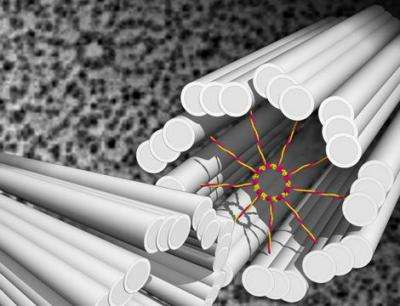Making cells turn cartwheels

Centrioles are barrel-shaped connection hubs that, like key Meccano parts, hold together the microtubule connection rods that form the structural framework of the cells in our bodies.
As cells grow and divide, they replicate their DNA before splitting into two daughter cells. Cells also duplicate centrioles every cell division, but much less is understood about the centriole formation. And as you might expect, errors in the formation of a critical component like a centriole are implicated in a number of conditions.
Dr Ioannis (John) Vakonakis, a Wellcome Trust Research Fellow in Oxford University's Department of Biochemistry , has worked with Swiss scientists on the structure of centrioles. They have just published a study in the journal Cell that offers conclusive evidence for what makes up a cartwheel structure with nine spokes seen at the centre of centrioles. OxSciBlog asked him about his work:
OxSciBlog: What are centrioles and what is their role in the cell?
John Vakonakis: Centrioles are large structures that exist in most eukaryotic cells. Their primary, ancient function is to organize and serve as basis for flagella and cilia, filaments that project from the cell that are used for cell motility and sensing. However, in animal cells centrioles are also used to organize the microtubule network, a kind of ‘motorway’ system in the cell used for transporting proteins and important during cell division.
OSB: Why is it important to know how they are organised?
JV: As centrioles are important for so many different processes their number inside the cell is carefully controlled. Effects that abnormally increase or decrease centriole numbers can lead directly to medical conditions, including male sterility and cancer. We need to understand how centrioles are formed and organised in order to understand how abnormalities occur.
OSB: You describe centrioles as being based on a structure like a cartwheel with nine spokes. This seems a strange symmetry for evolution to arrive at – is there a reason, is it crucial to the centriole's function?
JV: The short answer is: We don't know! Although our data show a clear preference for 9-fold symmetry, they do not tell us why evolution ended up with this symmetry as opposed to, for example, 8-fold or 10-fold. Nor is this the only odd symmetry to be seen in this system. Microtubules, organized by centrioles in animal cells, are 13-fold symmetric! Clearly, we need more work before we can fully understand this system.
OSB: What did you show in your Cell paper?
JV: We showed that SAS-6, a protein essential for centriole duplication (a process that occurs along with DNA replication as cells grow and divide), is sufficient to create 9-fold symmetric assemblies in vitro. These assemblies are strikingly similar to the ‘cartwheels’ observed early on in the centriole formation process.
OSB: What are the implications for understanding how the centriole carries out its role?
JV: Understanding how the centriole is organized allows us to probe its properties and its role in ways simply not possible earlier. For example, we can now ask questions about how regulatory mechanisms affect the assembly process we saw with SAS-6. We can form hypotheses about how centriole formation is controlled, and then test these hypotheses in novel experiments. We could even devise means to interfere on-demand with the SAS-6 assembly process, thereby being able to ‘switch’ centriole formation on or off!
OSB: Are there any implications for human health?
JV: Modulating centriole formation is of medical interest in a number of disease conditions, including cancer. The self-assembly process we have identified in SAS-6 is a novel target for controlling cell division and growth. Thus, we believe it may be used for medical intervention through therapeutics, although clearly there is a lot of work before we can reach that stage.
Provided by Oxford University
















